The Medicinal Uses of Turkey Tail (Trametes versicolor)
Turkey Tail (Trametes versicolor) is a polypore mushroom found across the world’s temperate, subtropical and tropical zones. It is the fruiting body of a white rot fungus that grows on wood, making it an essential part of ecosystemic recycling. It is beautiful to look at and relatively easy to identify. A large amount of medical research is underway on this mushroom, particularly related to diseases of the immune system (Hobbs 2004). Below, I go through some features of Turkey Tail and some easy ways to get to know it better so that you can incorporate its health benefits and earthy, mushroomy flavours into your life.
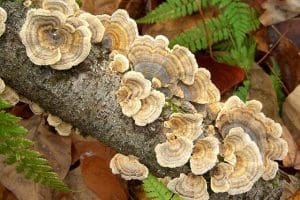
The thing to know about mushrooms is that they are to mycelium – a huge network of single-celled fungal threads – what grapes are to a vine. The vine is known as the fungus, while mushrooms are fruits – known more often as the fruiting body – that contain and disperse the spores, spreading the fungus further afield. If you’re a fungus, you need to be able to survive in a very competitive environment. You’re going to be excellent at cooperative, symbiotic strategies like releasing nutrients to other woodland organisms, as well as producing some highly antimicrobial chemicals that ward off true attackers. A very diverse system of chemistry arises from these fungal survival needs, which is why certain wild mushrooms can have such profound health impacts on human bodies.
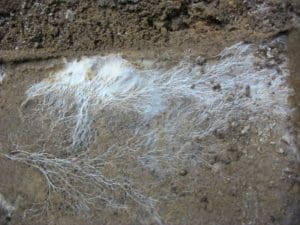
Mycelium as Medicine
Medicinally speaking, many benefits are available from the mycelium as well as the mushrooms themselves, and if you have ever bought a mushroom supplement, it’s likely that you got a dried form of mycelium grown on a starchy substrate like rice powder. It’s important to know your suppliers and their manufacturing practices; when I was training in herbal medicine, a well known Traditional Chinese Medicine (TCM) practitioner, Martin Powell (his company MycoNutri is an excellent source of high-quality mushroom powders), told us that many of the supplements commercially available are mostly undigested substrate because the mycelium is not allowed to grow to its full extent before the next stage of processing. Interestingly, he found that people still benefited from the mostly-substrate-pills, probably due to a combination of placebo (not to be underrated!) and that they might not get enough fibre from non-wheat sources in their normal diet.
If you grow your own mushrooms like oysters, either from kits or DIY setups, then you can experiment with powdering fully digested (when you have a block of fluffy white filaments with no sign of the original material) substrate and adding it to stocks, smoothies, crackers and breads. You get a different profile of medicinal actions from the mycelium because various kinds of fibre found in the fruiting bodies are absent. You might prefer the taste of one preparation over the other, and it becomes fascinating to experiment, learning more about fungal life cycles in the meantime.
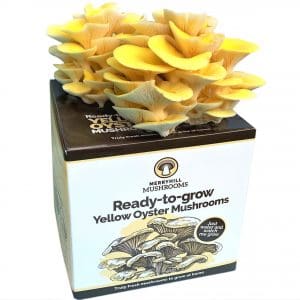
Needless to say, only do this with edible, non-toxic varieties! And use an edible substrate; I don’t suggest eating anything that might contain remnants of undigested sawdust or straw.
Turkey Tail mushrooms are very fibrous, so exclude themselves from the pile of juicy wild varieties you’ve got waiting to be sizzled with garlic and lemon. They lend themselves better to powdering, decocting into stocks, broths and teas, and using in ferments as a flavour agent. Thanks to the damp, wet rock nature of Britain, I’ve seen Turkey Tails in almost every season, making them ideal for experimenting with even though they lend themselves very well to drying. Providing you’re certain of your identification (ID GUIDE LINK HERE FOR TURKEY TAILS), you can get started. Only take mushrooms that look healthy, fresh and free of bug holes – using the same skills that gets you the good apples in a shop – and definitely don’t take everything from your patch. We want the spores to have a good chance of doing their job, and people are definitely low on the list of organisms for whom these mushrooms are essential.
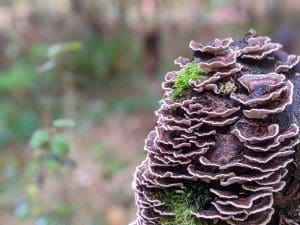
First, slice away any parts that retain dirt, moss or other remains of tree.
Whether you’re using Turkey Tail fresh or dried, it needs to be subjected to heat (preferably with moisture) or fermentation to break down a chemical called chitin, freeing up some of the very healthful chemicals. Decocting – simmering the mushroom in water for at least 30 minutes and up to 8 hours – is a classic way to accomplish this. Slow cookers are ideal pieces of kit. Roasting, as noted by https://nourishedkitchen.com/medicinal-mushroom-broth/, is another way to go about it, also liberating some sweeter, roasty toasty notes in the process. Of course, you could roast and then decoct, bringing greater depth of flavour and more complex chemistry to your broth.
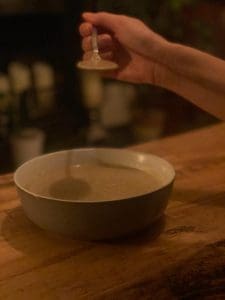
Turkey Tails Powdering, Herbal Uses and Benefits
It’s important to dry your mushrooms thoroughly before powdering them, otherwise, they will spoil. Use a dehydrator, rack over a wood stove, breezy rack in hot dry environments, paper bag in the airing cupboard, or any other drying method you have discovered. (Let us know your favourite drying and preservation techniques!)
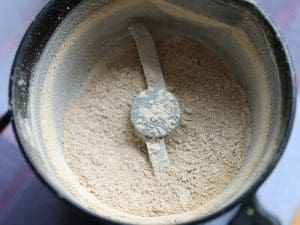
Once you have a powder, see what you think of the taste, and use it any way that would please you. You may find it more bitter than you are usually comfortable with; bitter, providing you know where it comes from, is good for you! It supports healthy digestion, and we all need to reschool our taste buds to some extent. You could add your Turkey Tail powder to miso broth, mix a few spoonfuls into stuffing, sauces, bread dough, crackers, spice mixes, flavoured salts, chutneys, cocktail ice cubes…the list is endless! Simple, creative reimaginings of well-known products make great gifts, as well as being extremely satisfying to make.
Benefits: Powders obviously contain the entire mushroom, including its fibrous body. There are two main ways that mushrooms support immune health; by supporting the immune cells themselves, and by attacking pathogenic microbes. Taking a powder means that your body is exposed to the greatest number of mushroom chemicals possible, and it will tend to know how best to deal with them.
Note: Some people, for reasons from gut dysbiosis to ulcers, may not get on with powders. If you experience any gastric upset at all, stop using the mushroom immediately.
Disadvantages: Powders lose their potency within about a year due to the small surface area and inevitable exposure to air.
Decocting Turkey Tails Mushrooms, Herbal Uses and Benefits
Simply pour water over your Turkey Tails – dried or fresh – and simmer for the amount of time it takes to get to the desired flavour for your intended use. The longer it stays in the water, the more large molecules you will extract. The larger molecules tend to taste more bitter and have antioxidant and antimicrobial actions. A decoction will last up to a week if refrigerated.
You could later dissolve sugar into your decoction to make a syrup – I tend to use 2 parts sugar to 3 parts liquid by weight – for additions to innovative desserts, coffees, cocktails or sauces.
You can drink a light decoction – simmered for maybe 30 minutes – as a regular tonic tea, perhaps infused with other tasty herbs. Think of it like an immune tonic, along the lines of Echinacea; it needs to be taken regularly to continue impacting your health positively. You may find that you have slightly more energy, or don’t get quite as many runny noses or chest infections. Pay attention to your body, and if it doesn’t suit you, then stop use immediately.
Add decoctions to soup stocks, broths and stews for a mushroomy flavour. Alternatively, you could include a decoction in the water portion of a bread, cake or use the liquid to cook grains or pulses.
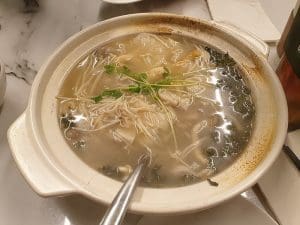
Fermenting Turkey Tails Mushrooms, Medicinal and Benefits
Introducing other microbes to the fibrous fruiting bodies means that chitin will be broken down and made more available and beneficial in terms of health. If you are a brewer, you can include roasted Turkey Tail mushrooms to your malt mash, or include some decoction in the liquid portion. Don’t overdo it – as discussed there is some antimicrobial action in Turkey Tail extracts, but it shouldn’t override the brewer’s yeast in sensible quantities. https://www.brewersfriend.com/homebrew/recipe/view/1139375/turkey-tail-mushroom-pale-ale has a run down of a Turkey Tail Mushroom Pale Ale.
For fans of Kombucha, water Kefir and other SCOBY (symbiotic culture of bacteria and yeast) ferments, infuse some wild mushrooms into the second ferment stage to introduce some novel flavours, e.g. https://realfoodrn.com/medicinal-ganoderma-kombucha-tea/.
Another option is to include some mushrooms in other vegetable lacto-ferments, or to bring them into koji products, explored here: https://foragerchef.com/pheasant-back-fermented-soy-sauce/.
Health Benefit Mechanisms
Ultimately, we want you to be equipped to support your health with delicious foods from the wild. Think in terms of tonics; foods that bring vitality into your life through long term use. If you have health concerns, remember that medical herbalists offer holistic healthcare options for a wide range of conditions. Because of the large range of chemistry available in Turkey Tail mushrooms, investigations are being carried out on diabetes, other endocrine disorders and chronic conditions. If you are interested in more detailed reports of the ways in which Turkey Tail mushrooms act on the immune system, including how they are being investigated as complements to chemotherapy in certain types of cancer, below are some useful links:
Useful Links
https://www.herbalgram.org/resources/herbalgram/issues/96/table-of-contents/hg96-resrvw-turkeytail/
https://draxe.com/nutrition/turkey-tail-mushroom/
https://www.dl.begellhouse.com/journals/708ae68d64b17c52,489762826cea4201,39339ece262c3632.html
https://link.springer.com/article/10.1186/s12906-019-2681-7
https://www.sciencedirect.com/science/article/pii/S0308814620322068
https://journals.plos.org/plosone/article?id=10.1371/journal.pone.0201131
References
Hobbs, C. (2004) Medicinal Value of Turkey Tail Fungus Trametes versicolor (L.:Fr.) Pilát (Aphyllophoromycetideae). A Literature Review. International Journal of Medicinal Mushrooms. 6: 195-218.






Leave a Reply
You must be logged in to post a comment.